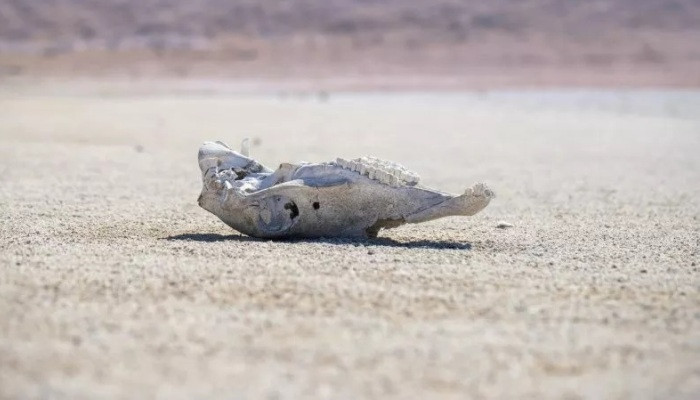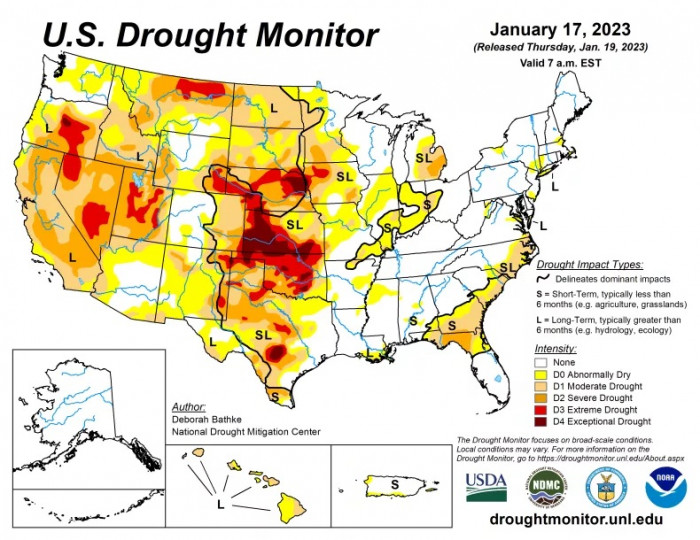If America's Megadrought Continues, the Impact Will Be Catastrophic
 he western half of the United States is currently experiencing a long-running megadrought that is putting a significant strain on water resources across the region, and experts say that another decade or two of dryness could have "catastrophic effects" on the country. The latest data from the U.S. Drought Monitor shows that 65 percent of the continental U.S. is experiencing some form of drought or abnormally dry conditions. Some of the hardest-hit states include Utah, Oregon, Nebraska, Kansas and Oklahoma, which all contain regions that are undergoing "extreme drought" conditions. "This region is experiencing an exceptional drought condition, with a severity that we have not seen in the past 1,200 years," Rick Relyea, director of the Darrin Fresh Water Institute at Rensselaer Polytechnic Institute, told Newsweek.Heavy rainfall over the past weeks affecting some parts of the western U.S. has helped to alleviate the drought in certain regions—notably California, where the percentage of the state categorized as being under extreme drought has dropped to practically zero.But despite the wet weather and flooding, more than 40 percent of the state is still considered to be under "severe" drought and much more precipitation will be needed over time to replenish reservoirs and groundwater stores. The megadrought is causing drinking water shortages in some areas and reductions in the quality of drinking water, as well as reducing the amount of water available for crops, industries and households. Water shortages in the western U.S. are being driven by increased demand from growing populations and other uses such as agriculture in combination with climate change, experts told Newsweek. "Water availability is always a balance between supply and demand," Relyea said. "For many regions in the western U.S., cities have experienced rapid growth over the past century but the water supply remained relatively steady. When the megadrought began, it caused water availability to decline while water demand continued to grow." Natural climate variability is a significant factor driving the current megadrought, although experts say anthropogenic global warming is playing a major role in the dry conditions many parts of the western United States are currently experiencing. One study published in the journal Nature Climate Change suggested human-caused climate change was responsible for more than 40 percent of the soil dryness over the 2000-2021 period, likely tipping what would have been a moderate drought into megadrought territory. When discussing the impact of the megadrought, David Feldman, a researcher with the University of California, Irvine, who specializes in water resources management, climate change policy and sustainable development, told Newsweek it is important to recognize that the effects differ widely at a local level, with some communities affected much more than others. "As a general rule, we'd have to say that the region as a whole is intensely affected," he said. "There are places throughout the southwest—smaller, rural communities—that are in the position of not having stable water supplies. There are other places that are water stressed, but probably to a slightly lesser degree. Some are less affected. So it does vary." But how might the situation progress in the foreseeable future? "This is the billion-dollar question," Relyea said. "It is hard—in fact, nearly impossible—to predict how much rain and snow will fall in future years. What we do know is that historic megadroughts have typically lasted 20-30 years, but that is no guarantee of when the current megadrought will end." "With continued climate change, we expect to see rain and snow events that are less frequent, but more intense," he said. "Such events can cause flash flooding, which makes it difficult for the water to slowly permeate into the soil to recharge the underground aquifers." While it is unclear how much longer the megadrought will last, some research has indicated that the dry period could continue for several more years yet, while water shortages are forecast to be widespread. Jonathan Deason, co-director of the Environmental & Energy Management Institute at George Washington University, and a professor in the School of Engineering and Applied Science told Newsweek he does not expect to see much if any, relief soon because even when dry conditions abate, it's going to take several years of above-average rainfall for there to be a significant recovery. Furthermore, a 2019 study that took into account future population growth and climate change projected that by 2071, nearly half of the 204 freshwater basins in the United States may not be able to meet the monthly water demand, without sufficient mitigation measures. If current trends persist, the drought will continue to affect the entire country both directly in certain regions where there will be insufficient water available for homes, businesses, and farms, and indirectly as a result of higher food costs, given the huge amount of food that is produced in the western half of the United States. The result of another decade or two of drought conditions would lead to "catastrophic effects" such as major aquifer depletions causing not only loss of groundwater resources but also land subsidence that will damage community infrastructure and even depletion of groundwater storage capacity, Deason said. "There also would be many other adverse effects such as increases in invasive species due to the death of native plants, increased wildfires, crop failures, inflationary pressures, and so on. These changes would affect well more than half of the U.S. population directly, and essentially all of the U.S. population either directly or indirectly." While continued drought would present significant problems, there are reasons to be optimistic, Feldman said. When you talk to water agencies, the actual organizations that are responsible for providing public water supply, or even when you talk to irrigation districts, they realize there is a problem and they are trying in various ways to do something about it," he said. "Water agencies are always thinking at least 20 years in advance of what they're going to do about their supplies and how they're going to supplement it. Climate change is a part of that formula. "The thing that worries me the most is not the competence or the capability of these water planners and agencies but the less regulated uses for which we have existing conflicts here in the west over water rights. That is to say, people fighting over withdrawals of water from streams or groundwater basins. As you have less water you're going to have more likelihood of conflict," he said. So, what can be done to mitigate water shortages amid the megadrought? "There are many things we can do, and in fact, are doing," Feldman said. "We do conserve—there are mandated cutbacks of water that we see during periods of drought. But we need to do much better." Continued drought for another decade or so would likely see residents, businesses, and farms in the region being subjected to more severe water rationing and increased use of water-conservation strategies. In homes, this may include retrofitting older housing stock and commercial buildings with low-flow water appliances as well as bans on watering lawns. In agriculture, which is the primary user in most areas, expanded efforts may be implemented to deploy water-saving irrigation technologies while farmers might shift to less water-thirsty crops. "The drought will also inspire a new generation of water-saving technologies," Relyea said. A persistent drought will also mean communities increasingly depend on having to import their water supply or share water supplies, according to Feldman. But aside from conservation measures, planners will need to "aggressively" adopt measures that already exist in some locations. "We need to recycle more wastewater. We are doing this already in some places," Feldman said. "You don't necessarily have to recycle the wastewater to a quality useful for drinking. You can use it for agricultural irrigation or landscaping, which in effect will conserve precious drinking water supplies. "We can also be harvesting more rainwater—this is done in various parts of the region now," he said. But we need to do this more aggressively. The climate models suggest that while we're going to have a longer period of drought, that may be punctuated by short and intense periods of very heavy precipitation. When that precipitation occurs, we need to figure out ways to capture and store it so that it can be used in the drier periods." Desalination is also an option that is available although it is very expensive, very energy intensive, and has some environmental impacts that will have to be mitigated."It's probably not likely to be the very first choice that most water providers will lean toward, but it probably will be in the mix in certain communities," Feldman said.  |

EU countries' ambassadors approve phase out of Russian gas imports
63810.12.2025, 16:01
Trump threatens Mexico with 5% tariff increase over water dispute
68109.12.2025, 22:18
Pentagon allocates $800 million for Ukraine over next two years
63008.12.2025, 12:00
The EU Council and Parliament strike a deal on rules to phase out Russian gas imports
96604.12.2025, 09:54
EU countries seek urgent plan B to fund Ukraine
88026.11.2025, 16:54
̀«Where the bishop is silenced, Christ is silenced»: Diradur Sardaryan
75824.11.2025, 00:10
